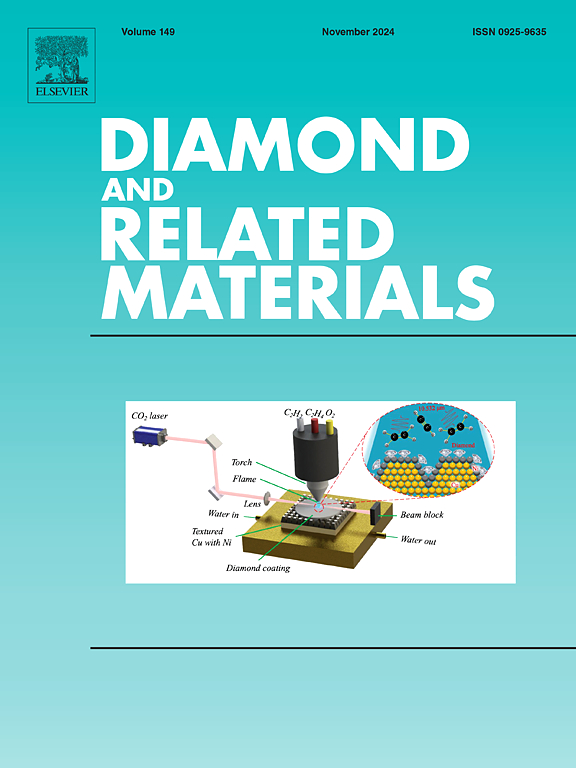Nitrogen-doped carbon/NiCo₂S₄ aerogel nanocomposite for solid-state supercapacitors
IF 4.3
3区 材料科学
Q2 MATERIALS SCIENCE, COATINGS & FILMS
引用次数: 0
Abstract
The conversion of biomass into valuable carbon materials reduces environmental pollution and develops effective porous carbon electrodes for energy storage devices. This study aims to prepare a novel composite material consisting of NiCo2S4 and chitosan-derived carbon (CNNA) for use in high-performance supercapacitors. The prepared CNNA composite exhibited a high specific surface area of more than 27 m2/g. The CNNA electrode delivered a high specific capacitance of 1282 F.g−1 at 1.0 A.g−1, significantly surpassing that of bare NiCo2S4 (340 F.g−1) under the same conditions. Electrochemical analysis revealed that the charge storage behavior involved both capacitive and diffusion-controlled contributions, with the capacitive contribution increasing at higher scan rates. Furthermore, a solid-state asymmetric supercapacitor (ACCS//CNNA) was assembled using CNNA as the positive electrode and chitosan-derived carbon aerogel (ACCS) as the negative electrode. The device achieved a specific capacitance of 199 F.g−1, an energy density of 62 Wh.kg−1, and a power density of 750 W.kg−1, and retained 90.9 % of its initial capacitance after 10,000 charge–discharge cycles. These results clearly demonstrate the synergistic effect of NiCo2S4 and N-doped carbon aerogel, highlighting the potential of CNNA as a sustainable and efficient electrode material. Using chitosan in NiCo2S4/carbon composites offers advantages, including nitrogen self-doping, the formation of a uniform nanostructure, and enhanced electrochemical performance compared to composites made from other biomass sources.

固态超级电容器用氮掺杂碳/NiCo₂S₄气凝胶纳米复合材料
生物质转化为有价值的碳材料减少了环境污染,并开发了用于储能装置的有效多孔碳电极。本研究旨在制备一种由NiCo2S4和壳聚糖衍生碳(CNNA)组成的新型复合材料,用于高性能超级电容器。制备的CNNA复合材料具有超过27 m2/g的高比表面积。在1.0 A.g−1条件下,CNNA电极的比电容高达1282 F.g−1,显著优于NiCo2S4裸电极(340 F.g−1)。电化学分析表明,电荷存储行为包括电容控制和扩散控制两方面的贡献,随着扫描速率的提高,电容控制的贡献增加。此外,以CNNA为正极,壳聚糖衍生碳气凝胶(ACCS)为负极,组装了固态不对称超级电容器(ACCS//CNNA)。该器件的比电容为199 F.g−1,能量密度为62 Wh。功率密度为750 W.kg - 1,在10,000次充放电循环后保持了90.9%的初始电容。这些结果清楚地证明了NiCo2S4和n掺杂碳气凝胶的协同效应,突出了CNNA作为可持续和高效电极材料的潜力。与其他生物质材料制备的复合材料相比,壳聚糖在NiCo2S4/碳复合材料中具有氮自掺杂、形成均匀纳米结构和增强电化学性能等优点。
本文章由计算机程序翻译,如有差异,请以英文原文为准。
求助全文
约1分钟内获得全文
求助全文
来源期刊

Diamond and Related Materials
工程技术-材料科学:综合
CiteScore
6.00
自引率
14.60%
发文量
702
审稿时长
2.1 months
期刊介绍:
DRM is a leading international journal that publishes new fundamental and applied research on all forms of diamond, the integration of diamond with other advanced materials and development of technologies exploiting diamond. The synthesis, characterization and processing of single crystal diamond, polycrystalline films, nanodiamond powders and heterostructures with other advanced materials are encouraged topics for technical and review articles. In addition to diamond, the journal publishes manuscripts on the synthesis, characterization and application of other related materials including diamond-like carbons, carbon nanotubes, graphene, and boron and carbon nitrides. Articles are sought on the chemical functionalization of diamond and related materials as well as their use in electrochemistry, energy storage and conversion, chemical and biological sensing, imaging, thermal management, photonic and quantum applications, electron emission and electronic devices.
The International Conference on Diamond and Carbon Materials has evolved into the largest and most well attended forum in the field of diamond, providing a forum to showcase the latest results in the science and technology of diamond and other carbon materials such as carbon nanotubes, graphene, and diamond-like carbon. Run annually in association with Diamond and Related Materials the conference provides junior and established researchers the opportunity to exchange the latest results ranging from fundamental physical and chemical concepts to applied research focusing on the next generation carbon-based devices.
 求助内容:
求助内容: 应助结果提醒方式:
应助结果提醒方式:


